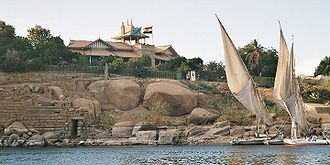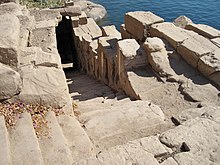Elephantine Nilometer (Satis Temple)
The Nilometer of Elephantine in the area of on the eastern bank of the Nile to the eastern Elephantine built -Nilinsel Satis temple is the oldest preserved Nilometer from ancient Egypt . Sesostris I ( 12th Dynasty ) had at the beginning of the second millennium BC Create several nilometers in Egypt, including on the site of the Satis Temple. The renovations and renovations made during the Greco-Roman period are still preserved today.
Location and structure
The Nilometer is north of the Satis Temple and is connected to the river terrace of the sanctuary. The partially covered staircase leads down to the eastern bank of the Nile from Elephantine. To the north of it is a ritual nilometer, which was built as a monumental staircase in the second century; south of the third kilometer on the terrain of the Khnum temple. In the Greco-Roman period, the three Nilometers functioned as a focal point for the annual processions . From the starting point of the monumental staircase, the processional path led over the Nilometer of the Satis Temple to the Nilometer of the Khnum Temple.

On the western wall of the stairs from the Nilometer of the Satis Temple, multiple subdivided sections of the water levels are attached. The lower edge of the Nilometer on the banks of the Nile begins with the Nile mark “ 16 ells ” and initially leads to the upper mark “27 ells”. The water levels correspond to a height of 85.86 meters to 92.31 meters above sea level . Above the 17th cubit there is a so-called rectangular Semeion (symbol) , which symbolized the lower threshold value of an agriculturally good Nile flood . The second area of the staircase begins at the top of the 27th cubit and goes up to a height between 31 and 32 cubits (94.59 meters).
There are no markings in the second section. This finding confirms archaeological results, according to which there have been Nile flood heights in the measurable lower staircase sections since the 2nd dynasty . Extreme tide heights could still be measured if necessary due to the upper orientation. Taking into account the old water levels from the Old Kingdom and the early dynastic period , this measure seems understandable, since at the beginning of the first dynasty, at the beginning of the third millennium BC. In Elephantine flood heights of 94.25 meters were regularly reached.
Nile flood heights
The lowest water levels in the Nile fell in the 19th century AD with 11 to 15 cubits in the period from April to the end of May / beginning of June . The existing Nile heights in Elephantine were in the range of 83.5 to 85.5 meters above sea level and thus about 2 meters above the level of the Greco-Roman period of 6 to 11 cubits. From the 22nd cubit to the peak of the flood , about 28 days pass in Elephantine until the end of August . In total, the Nile needs about 56 days for the ascent from the 15th cubit to the apex of the Nile flood in relation to the Nilometer of the Satis Temple. The Nile remains near its peak for about 6 to 10 days before it begins to plummet again.
The total period until the fall of the Nile flood corresponds to 6 to 7 decades in the ancient Egyptian calendar . Another 2 to 3 decades were assigned to the decline. The measurements of the nilometer therefore covered an average of 9 decades (90 days) and thus about 3 lunar months . The middle Nile flood lunar month was considered a critical time , as at the end of the month the Nile usually exceeded the mark of 22 cubits, which, like the upper area of the neighboring monumental staircase of Elephantine, symbolized this point in time as the "successful arrival of the Nile flood" and thus the beginning of the Nile festival Semasia signaled, which has been documented since the Greco-Roman times. The Nile flood inscriptions in the temple of Akoris show that the priests accompanied the ascent of the Nile up to the 22 cubit mark with ritual incantations. For the epoch from 284 to 305 AD, reaching that height of the Nile between August 3rd and 16th is documented; about 9 days later as Elephantine.
The determination of the average Nile flood heights is based on archaeological results, stelae information , entries on the annals stone of the 5th dynasty , news from ancient authors, the Nilometer statistics and the values from the Nilometer of the Satis Temple; in the 20th century on reconstruction of the heights of the Nile. Comparative values from the 19th century show the average reaching the mark of “16 yards” (about 88.5 meters) from mid- July ; “19 cubits” around the end of July / beginning of August and the highs between the end of August and the beginning of September . In ancient Egyptian history, the heliacal rise of Sirius usually took place before reaching the "16 cubits mark" in Elephantine and thus before the "regular arrival of the flood".
| Average height of the Nile flood in Elephantine ( predynastic up to 20th century) | ||||||
| Period | epoch | Height above sea level | Height in cubits | |||
|---|---|---|---|---|---|---|
| Late 4th millennium BC Chr. | Naqada III | 96.85 meters | 34.74 cubits | |||
| Beginning of the 3rd millennium BC Chr. | 1st dynasty | 92.99 meters | 28.01 cubits | |||
| Beginning of the 3rd millennium BC Chr. | 2nd dynasty | 91.76 meters | 25.92 cubits | |||
| Beginning of the 3rd millennium BC Chr. | 3rd dynasty | 91.73 meters | 25.89 cubits | |||
| Middle of the 3rd millennium BC Chr. | 4th dynasty | 91.93 meters | 26.08 cubits | |||
| Middle of the 3rd millennium BC Chr. | 5th dynasty | 91.79 meters | 26.11 cubits | |||
| Late 3rd millennium BC Chr. | 6th dynasty | 91.05 meters | 24.85 cubits | |||
| Old Kingdom (3rd millennium BC) | 1st to 6th dynasty | 91.53 meters | 25.66 cubits | |||
| End of the 3rd millennium BC Chr. | 1. Intermediate time | 91.45 meters | 25.53 cubits | |||
| Middle of the 1st millennium BC Chr. | Late period | 91.49 meters | 25.61 cubits | |||
| End of the 1st millennium BC Chr. | Ptolemaic period | 91.51 meters | 25.64 cubits | |||
| Beginning of the 1st millennium | Greco-Roman time | 91.03 meters | 24.82 cubits | |||
| 19th century | 1869 to 1898 | 93.08 meters | 28.31 cubits | |||
| 20th century | First half | 92.42 meters | 27.19 cubits | |||
| 20th century | 1968 to 1973 | 91.91 meters | 26.32 cubits | |||
See also
literature
- Stephan Seidlmayer : Historic and modern Nile stands. Investigations into the level readings of the Nile from the early days to the present . Achet, Berlin 2001, ISBN 3-9803730-8-8
Web links
- Map of the Nilometer from the Satis Temple
- Stair nilometer (level markers from the Greco-Roman period)
Individual evidence
- ↑ Stephan Seidlmayer: Historic and modern Nile stands. ... Berlin 2001, pp. 56-57.
Coordinates: 24 ° 5 ′ 5 " N , 32 ° 53 ′ 15" E



